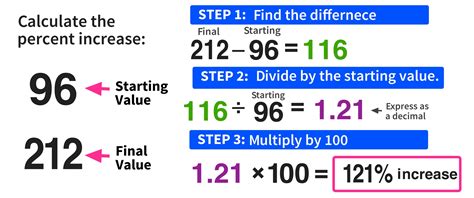How to Calculate Increase: A Simple Guide
Calculating an increase, whether it's in sales, website traffic, or your savings account, is a fundamental skill with broad applications. This guide breaks down the process, offering clear examples and tips to ensure you master this essential calculation.
Understanding the Basics: Percentage Increase
A percentage increase shows the relative growth of a value over time. It's expressed as a percentage of the original value. The core formula is:
[(New Value - Old Value) / Old Value] x 100% = Percentage Increase
Let's dissect this:
- New Value: The final value after the increase.
- Old Value: The initial value before the increase.
This formula calculates the difference between the new and old values, then expresses that difference as a proportion of the original value, finally converting it to a percentage.
Example Calculations: Percentage Increase
Let's illustrate with some real-world scenarios:
Scenario 1: Website Traffic Increase
Suppose your website had 1000 visitors last month and 1200 visitors this month. To calculate the percentage increase:
- New Value: 1200
- Old Value: 1000
[(1200 - 1000) / 1000] x 100% = 20%
Your website traffic increased by 20%.
Scenario 2: Sales Growth
Your company's sales were $50,000 last quarter and $60,000 this quarter. What's the percentage increase?
- New Value: $60,000
- Old Value: $50,000
[($60,000 - $50,000) / $50,000] x 100% = 20%
Sales increased by 20%.
Scenario 3: Savings Account Growth
Your savings account balance was $1000 and grew to $1050. What's the percentage increase?
- New Value: $1050
- Old Value: $1000
[($1050 - $1000) / $1000] x 100% = 5%
Your savings grew by 5%.
Calculating Percentage Decrease
The formula is very similar, just remember it's a decrease:
[(Old Value - New Value) / Old Value] x 100% = Percentage Decrease
Notice the order of subtraction is reversed.
Beyond the Basics: Applications and Tips
Understanding percentage increase is crucial for:
- Tracking business performance: Monitor sales, profits, customer acquisition, and more.
- Analyzing investment returns: Evaluate the growth of your investments.
- Comparing data sets: Identify trends and make informed decisions.
- Personal finance: Track savings growth, budget changes, and debt reduction.
Tips for Accurate Calculations:
- Double-check your values: Ensure you're using the correct new and old values.
- Use a calculator: Avoid manual calculation errors, especially with larger numbers.
- Understand the context: Always consider the meaning behind the percentage increase – a large percentage increase on a small base value might not be as significant as a smaller percentage increase on a large base value.
Mastering percentage increase calculations empowers you to analyze data effectively and make better decisions in various aspects of your life and work.
